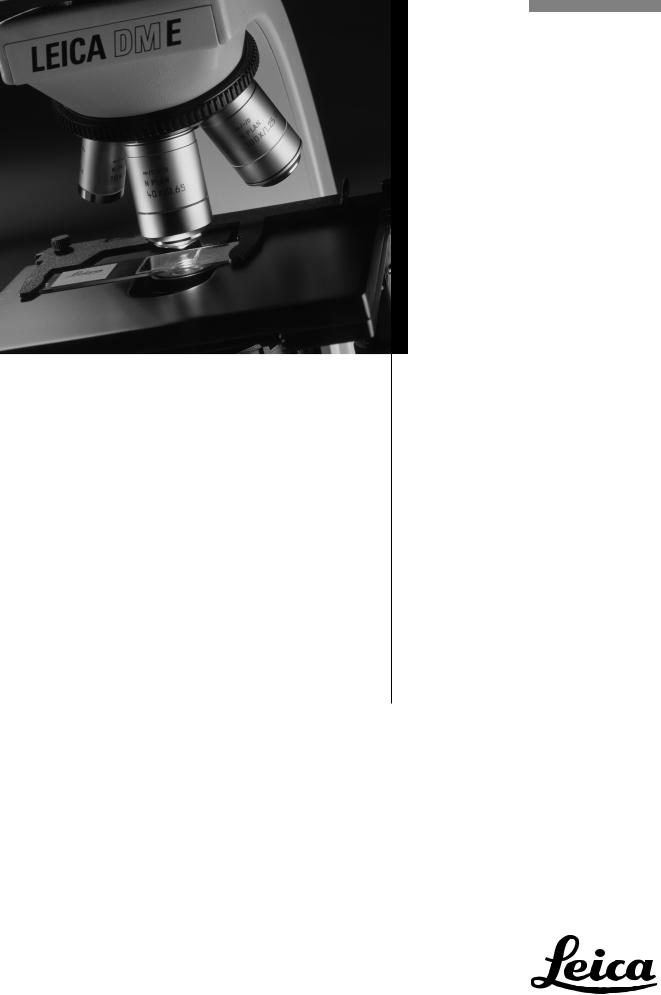Leica DM E User Manual [en, de, fr, it]

LeicaDME
Instruction Manual Gebrauchsanleitung Mode d’emploi Manual de instrucciones Manuale di istruzione
M I C R O S Y S T E M S

1
ENGLISH

LeicaDME
InstructionManual
Contents
1.0 Introduction |
................................................................. |
|
2 |
2.0 Unpacking |
................................................................. |
|
2 |
3.0 Preparation For Use |
3.1 |
Viewing Body................................. |
2 |
|
3.2 |
Installing Objectives ...................... |
3 |
|
3.3 |
Substage Condenser..................... |
3 |
|
3.4 |
Filters .............................................. |
3 |
4.0 Operation |
|
......................................................... |
3 |
5.0 Care of Microscope |
5.1 |
General........................................... |
4 |
|
5.2 |
Mechanical Maintenance ............ |
4 |
|
5.3 |
Lamp Replacement........................ |
4 |
|
5.4 |
Electrical Considerations/ |
|
|
|
Equipment Ratings......................... |
5 |
|
5.5 |
Fuse Replacement......................... |
5 |
Explanation of Warning Symbols
CAUTION: Replace with same type and rating fuse: 5x20mm, 3.15 Amp/250V, Quick acting (# 13WFAG30001)
|
CAUTION: Risk of |
|
CAUTION: (Refer to accom- |
|
|
||
|
electric shock |
|
panying documents) |
|
|
|
|
1.0 Introduction
Thank you for purchasing the DM E from Leica Microsystems. The Leica DM E Compound Microscope combines exclusive design features and a full range of accessories making it a truly versatile, quality instrument for advanced academic and routine clinical applications.
CAUTION: This instrument should only be used as described. Hazards may result if used improperly.
2.0 Unpacking
Carefully remove the microscope components from the packing carton. Check the components against the following standard equipment list:
1. |
Stand: includes focusing |
5. |
Condenser |
|
mechanism, graduated |
6. |
Immersion Oil |
|
mechanical stage, |
7. |
Spare Lamp |
|
nosepiece and integral |
8. |
Dust Cover |
|
illumination system. |
9. |
Power Cord |
2. |
Viewing Body |
10. |
Blue Filter |
3. |
Objectives |
11. |
3mm Allen Wrench |
4. |
Eyepiece(s) |
|
|
Optional items such as contrast accessories, camera adapters and systems, multiviewing systems and carrying cases are not shipped as part of the standard equipment. These items are delivered in separate packages.
Please do not discard any of the packing materials. They should be used for safely storing and transporting the instrument should the need arise.
3.0PreparationforUse
3.1Viewing Body
Attach the viewing body to the stand by backing off the set screw on top of the stand with the tool provided. Then insert the dovetail of the viewing body into the stand support and tighten the set screw firmly without forcing it. This precisely locates the body on the optical axis of the microscope, regardless of the selected orientation. After the body is attached, insert the eyepieces into the eyetubes. Attach the power cord and turn on the DM E using the knurled dial on the lower left side. Note the dial will be illuminated.
2
English

The binocular and trinocular bodies maintain a constant tube length for all interpupillary settings. This means that a change of interpupillary distance does not affect parfocality, magnification or calibrations which depend on magnification. Interpupillary distance is changed by simply spreading or pushing eyetubes. They will hold their position at the appropriate setting.
If you have purchased a standard or custom outfit, you will notice the objectives are already installed on the nosepiece and the condenser is in place under the stage. In this case, go to the OPERATION section. If you purchased your DM E in components, please continue.
3.2 Installing Objectives
The standard achromatic objectives are safeguarded against theft by a rotatable exterior plastic sleeve. This plastic sleeve must first be removed from the actual objective mount before the objective is inserted into the nosepiece. The sleeve is released by pressing in a hole at the upper edge of the sleeve. This is done with a pointed object, such as a pen. Attach the objectives to the revolving nosepiece holes counterclockwise from the lowest magnification to the highest. Always rotate the nosepiece by using the knurled nosepiece ring.
When the achromatic objectives have been inserted into position, push the sleeves onto the objectives until the circle on the spring ring engages in the hole of the sleeve again. Be sure the sleeves have snapped in place. No special measures are necessary for screwing other types of objectives into the objective nosepiece.
3.3 Substage Condenser
Adjust the condenser mount to its lowest position, then push the substage condenser into the fork mount underneath the stage by aligning the positioning pin into the slot. Two centering screws are included to properly align the substage condenser. Tighten the two centering screws to roughly center the substage condenser with the supplied tool. Each condenser is furnished with an iris diaphragm which controls the effective numerical aperture of the objective. To open and close this diaphragm, simply rotate the condenser ring to the right or to the left. Center the condenser in the following way: Close the aperture, raise the condenser to the top, remove an eyepiece and use the provided tool or set screws with the centering screws to center the condenser by observing the aperture through the eyetube.
3.4 Filters
The blue filter is factory installed in the underside of the condenser. For phase contrast applications replace the blue filter with the green filter. Special care must be used in handling filters. Scratches and fingerprints will result in poor images and lower light levels.
3
4.0 Operation
CAUTION: As a safety precaution, the power cord has been grounded to the microscope base. Never use an adapter between the power cord and the power source; it will render the grounding feature ineffective.
CAUTION : The top collector lens of the illumination system in the base of the microscope may become warm or hot. Avoid touching the lens directly.
4.1Always use your microscope on a hard, stable surface.
4.2Plug the microscope power cord into a suitable grounded electrical outlet. A grounded 3-wire cord is provided.
4.3Turn on the microscope by rotating the illumination control knob on the bottom left side of the instrument.
4.4Set the illumination control knob to the lowest setting. The illumination control allows you to adjust the intensity of light produced by the illumination system.
4.5Fully open the aperture diaphragm of the condenser by rotating the ring to the extreme right.
4.6Using the substage condenser focusing knob, raise the condenser to the top of its excursion. Critical illumination only: If the condenser travel is excessive, limit the travel with the thumb screw under the substage until the top lens of it is just below the stage surface (0.35mm).
4.7Place a specimen slide on the stage.
4.8Rotate the nosepiece to move the 4x objective into working position.
4.9Raise the stage by rotating the coarse adjustment knob to its positive stop. Using the fine adjustment knob, bring the specimen into sharp focus. The DM E has been factory adjusted such that stage focus can be found 1.5 rotations of focus adjustment.
4.10Adjust the eyetubes for interpupillary distance and eye difference.The left eyepiece tube is focusable to compensate for refractive differences of the eyes. To correctly set the eyetubes, focus on the specimen through the right eyepiece tube only. Use the fine adjsutment knob while covering the left eyepiece or closing the left eye. Next, focus the specimen throught the left eyepiece by turning the eyetube. Cover the right eyepiece while doing this and be sure to focus with the left eyetube only, without using the focusing knob.
English

4.11Remove an eyepiece and view the back aperture of the objective. Close the condenser aperture diaphragm and then, to obtain the full resolving power of the microscope, reopen until the diaphragm leaves just disappear from view.
Replace the eyepiece. The aperture diaphragm can be adjusted to enhance contrast and/or increase the depth of focus.
4.12When changing to higher power objectives, the positions of the aperture diaphragm must be reset. As magnificaton increases, the aperture diaphragm must be opened as required.
5.0Care of the Microscope
5.1General
Keeping all optical components clean is important for maintaining good optical performance. The microscope should always be covered with the plastic dust cover provided with the instrument when it is not in use. If any optical surface becomes badly coated with dust or dirt, it should be cleaned by blowing it off with a syringe or brushing it off with a camel hair brush before attempting to wipe the surface clean.
Optical surfaces should be cleaned with a lint-free cloth, lens tissue or a cotton swab moistened with methanol or commercially available glass cleaner. It is very important to avoid the excessive use of solvent. The cloth lens tissue or cotton swab should be moistened with solvent, but not be wet enough for the solvent to seep around the lens.
No part of the microscope is quite so vulnerable to dirt, dust and oil as the front lens of the objective. Whenever lack of contrast, cloudiness or poor definition is encountered, carefully check the condition of the front lens with a magnifier.
The lower magnification objectives have fairly large front lenses and can be cleaned with a cloth or lens tissue wrapped around a finger and moistened with methanol. The 40x and 100x objectives require a little more care and examination with a magnifier.
To achieve the high degree of flatness obtained with the higher magnification objectives, it is necessary to use a small concave front lens of fairly short radius or curvature. The surface of this front lens can be readily cleaned with a toothpick covered with a cotton tip, or with a small cotton swab. Moisten the cotton with methanol and squeeze it almost dry. Wipe the front lens lightly without applying undue force or scrubbing action. Make sure that the cotton tip contacts the concave lens surface. Check the objective with a magnifier after cleaning.
Should you need to remove the viewing body, be careful not to accidentally touch the outer lens surface on the underside of the body. Finger prints on this surface will reduce image clarity. This lens can be cleaned in the same manner as objectives and eyepieces.
5.2 Mechanical Maintenance
Using the dust cover is the most important factor in keeping the microscope in good mechanical and physical condition.
The Leica DM E has a durable finish. All non-optical parts of the instrument can be cleaned with methanol, naptha or soap and water. Avoid the use of all other organic solvents when cleaning the instrument.
5.3 Lamp Replacement
CAUTION: Unplug the instrument before attempting to change
the lamp.
CAUTION: The glass envelope of the lamp may be extremely hot. Do not attempt to change the lamp before it is completely cooled or without wearing adequate skin protection. The glass should not be handled with bare hands. If the lamp is touched with bare hands clean the surface with a lens tissue and methanol prior to installation.
The only component in the Leica DM E that may require periodic replacement is the illuminator lamp.
12V, 20W Halogen replacement lamp . . . . . . . . . .# 13596025 12V, 35W Halogen replacement lamp . . . . . . . . . .# 13596030
A.Before replacement, unplug the instrument.
B.Open the lamp door by pulling locking pin
C.After it has cooled, carefully hold the lamp using a lens cloth and remove it from its socket.
D.Place the new lamp into the socket using a lens cloth.
E.Close the lamp door, being sure to push the locking pin in until it stops.
F.Never operate the microscope illuminator unless the lamp door is securely closed.
5.4 Electrical Considerations / Equipment Ratings
CAUTION: Risk of electric shock. Removal of the bottom cover of the microscope exposes hazardous voltages, which if contacted, could cause injury or death. Please refer servicing to qualified personnel.
4
English

Supply Voltage and Range Supply Frequency
85-265 VAC, 50/60 Hz
Input power |
20W lamp |
21W |
Input power |
35W lamp |
37W |
Maximum Power - 45W |
|
|
Range of Environmental Conditions
•Altitude up to 2000m
•Indoor use only
•Temperatures 5°C to 40°C
•Installation Category II (Overvoltage Category)
•Pollution degree 2
5.5 Fuse Replacement
CAUTION: Unplug the instrument before changing any fuses.
The Leica DM E has two fuses located next to the power cord receptacle. Use only fuse type:
 5x20mm, 3.15 Amp/250V, Quick acting (# 13WFAG30001)
5x20mm, 3.15 Amp/250V, Quick acting (# 13WFAG30001)
5
English

LeicaDME
Gebrauchsanleitung
Inhalt |
|
|
|
1.0 |
Einführung |
................................................................. |
6 |
2.0 |
Auspacken |
................................................................. |
6 |
3.0 |
Vorbereitung |
Tubus ........................ ................................ |
6 |
|
zum Gebrauch |
Einbau der Objektive ............................. |
7 |
|
|
Kondensor .............................................. |
7 |
|
|
Filter ......................................................... |
7 |
4.0 |
Funktion |
................................................................. |
7 |
5.0 |
Pflege des |
Allgemein ............................................... |
8 |
|
Mikroskops |
Mechanische Pflege.............................. |
8 |
|
|
Lampenwechsel ..................................... |
8 |
|
|
Elektrik..................................................... |
9 |
|
|
Sicherungswechsel ............................... |
9 |
ERKLÄRUNG DER WARNSYSMBOLE
VORSICHT: Mit einer Sicherung des gleichen Typs und gleicher Leistung austauschen: 5x20mm, 3.15 A/250V, flink (Nr. 13WFAG30001)
|
VORSICHT: |
|
VORSICHT: (siehe beiliegende |
|
|
||
|
Stromschlaggefahr |
|
Unterlagen |
|
1.0 Einführung
Wir danken Ihnen für den Kauf des Leica DM E. Das Leica DM E ist ein Lichtmikroskop für die mikroskopische Ausbildung. Sein umfangreiches Zubehörprogramm macht es weiterhin geeignet für alle Anwendungen der anspruchsvollen Routine.
VORSICHT: Bitte benutzen Sie das Instrument nur in beschriebener Art und Weise. Unsachgemäße Verwendung kann gefährlich sein.
2.0 Auspacken
Die Mikroskopbauteile vorsichtig aus dem Packkarton nehmen. Die Bauteile anhand der folgenden Standard-Ausrüstungsliste überprüfen:
1. |
Stativ |
7. |
Ersatzbirne |
2. |
Tubus |
8. |
Staubschutzhülle |
3. |
Objektive |
9. |
Netzkabel |
4. |
Okulare |
10. |
Blaufilter |
5. |
Kondensor |
11. |
3 mm Innensechskant- |
6. |
Immersionsöl |
|
Schraubenschlüssel |
Optionales Zubehör für Kontrastierverfahren, Kameraadapter und –systeme, Diskussionstuben sowie Transportkoffer werden nicht als Teil der Standardausrüstung ausgeliefert. Diese Teile werden in getrennten Verpackungen verschickt.
Bitte das Verpackungsmaterial nicht entsorgen. Es kann bei Bedarf zum sicheren Aufbewahren und Transport des Instruments verwendet werden.
3.0Vorbereitung zum
Gebrauch
3.1Tubus
Den Tubus am Stativ anbringen, indem die Schraube an der Oberseite des Stativs mit dem beigefügten Inbusschlüssel gelöst wird. Dann den Schwalbenschwanz des Tubus auf das Stativ setzen und die Fixierschraube fest anziehen. Danach die Okulare in die Okularstutzen stecken.
Die Beobachtungsund Phototuben halten dank ihres Konstruktionsprinzips die optische Wegeslänge stets konstant . Das bedeutet, dass eine Änderung der Augenabstandes (Wechsel des
6
Deutsch

Beobachters) sich nicht auf Schärfeeinstellung oder Vergrößerung auswirkt. Der Augensabstand läßt sich durch einfaches Auseinanderbewegen oder Zusammenschieben der Okularstutzen ändern. Er ist von jeden Nutzer individuell einzustellen.
Wenn Sie sich für eine Komplett-Ausstattung entschieden haben, sind die Objektive werkseitig bereits am Objektivrevolver eingeschraubt und der Kondensor bereits im Kondensorhalter fixiert und zentriert. In diesem Fall lesen Sie bitte weiter in Kapitel FUNKTION. Haben Sie Ihr DM E individuell zusammengestellt, lesen Sie bitte unter 3.2 Einbau der Objektive weiter.
3.2 Einbau der Objektive
Die achromatischen Standardobjektive sind durch eine drehbare äussere Kunststoffhülse gegen Diebstahl geschützt. Diese Kunststoffhülse muss zuerst von der eigentlichen Objektivfassung gelöst werden, bevor das Objektiv in den Objektivrevolver eingeschraubt werden kann. Die Hülse lässt sich durch Drücken in die Bohrung an der Oberkante der Hülse lösen. Dazu einen spitzen Gegenstand, z. B. die Spitze eines Bleistifts, verwenden. Die Objektive in den Objektivrevolver nacheinander von der kleinsten bis zur stärksten Vergrösserung einsetzen. Vergrösserungswechsel erfogt immer mit Griff an den gerändelten äusseren Ring des Objektivrevolvers.
Wenn die achromatischen Objektive eingesetzt sind, die Hülsen über die Objektive stülpen, bis der Zapfen auf dem Federring in das Loch der Hülse greift. Sicherstellen, daß die Hülsen eingerastet sind.
3.3 Kondensor
Den Kondensorhalter in die niedrigste Stellung bringen, dann den Kondensor in die Aufnahme des Kondensorhalters drücken, indem der Positionierstift zum Schlitz hin ausgerichtet ist. Die zwei Zentrierschrauben mit dem beigefügten Werkzeug zum groben Zentrieren des Kondensors einschrauben. Jeder Kondensor ist mit einer Irisblende (=Aperturblende) ausgestattet, um die Beleuchtungsapertur zu regeln. Zum Öffnen und Schließen der Irisblende einfach den Ring am Kondensor nach rechts oder links drehen. Den Kondensor folgendermaßen zentrieren: Die Blende schließen, den Kondensor ganz nach oben fahren, ein Okular herausnehmen und in den Tubus schauen. Das Bild der Aperturblende soll zentral in der hinteren Brennebene des Objektives zu beobachten sein.
3.4 Filter
Der Blaufilter ist werkseitig im Kondensor montiert. Bitte beachten Sie, dass die Oberfläche der Filter empfindlich gegen Kratzer und Verunreinigungen ist.
7
4.0 Funktion
VORSICHT: Als Sicherheitsmaßnahme wurde das Netzkabel des Mikroskops geerdet. Nie einen Adapter zwischen dem Netzkabel und der Stromquelle verwenden, dadurch wird die Erdung unwirksam.
4.1Benutzen Sie Ihr Mikroskop immer auf einem harten, stabilen Untergrund.
4.2Stecken Sie das Netzkabel des Mikroskops in eine geeignete, geerdete Steckdose. Ein geerdetes Netzkabel ist mitgeliefert.
4.3Das Mikroskop durch Drehen des Beleuchtungsreglers auf der linken Seite des Instruments einschalten.
4.4Den Beleuchtungsregler auf die niedrigste Stufe einstellen
4.5Die Blende des Kondensors durch Drehen des Rings öffnen
4.6Mit der Höheneinstellung des Kondensorsträgers den Kondensor ganz nach oben fahren. Sollte der Kondensor zu hoch gefahren werden können (Kollision mit dem Objektträger!), kann die Höhenanschlagschraube auf der Unterseite des Kondensorträgers entsprechend nachgestellt werden.
4.7Einen Objektträger auf den Mikroskoptisch legen.
4.8Das Objektiv 4x einschwenken.
4.9Den Mikroskoptisch mittels Grob-Fokustrieb in die höchste Position bringen. Mit dem Feintrieb nachfokussieren.
4.10Den Tubus auf Augenabstand und Sehschärfeausgleich einstellen. Hierzu durch das rechte Okular schauen und mittels Feintrieb fokussieren. Das linke Okular dabei abgedeckt lassen oder das linke Auge geschlossen halten. Dann mit dem linken Auge durch das linke Okular schauen und mittels Einstellmöglichkeit am Okularstutzen fokussieren. Auf keinen Fall den Grob/Feintrieb hierzu benutzen.
4.11Ein Okular herausnehmen und in den Tubus schauen. Die hintere Brennebene des Objektives zeigt das Bild der Aperturblende. Volle Auflösung ist theoretisch bei voll geöffneter Blende möglich. Der Bildkontrast verlangt aber ein Schliessen der Blende um ca. 1/3. Präparate mit hohem Eigenkontrast erlauben ein Öffnen der Blende.
4.12Wenn zu leistungsstärkeren Objektiven gewechselt wird, muss die Aperturblende nachgeregelt werden.
Deutsch
